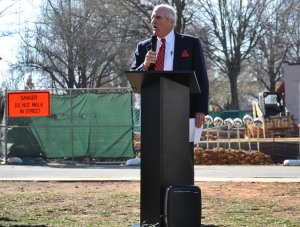-
Senior outfielder Emerald Graham watches a pitch in a Feb. 20 game from East Field. File photo by Merissa Blitz.
Sometimes all it takes is a change of mindset.
Such was the case for the Elon women’s softball team as it traveled to Columbia, S.C., for two games against the University of South Carolina Gamecocks Feb. 26.
While losing its first game 2-0, the Phoenix rebounded to defeat the Gamecocks 8-1 in the nightcap.
“The main difference in the games is that we made adjustments hitting,” head coach Patty Raduenz said. “We came out the second game with more energy and were able to take advantage of their pitching mistakes to get a victory.”
The pitching mistakes came right away, as Gamecocks freshman pitcher Julie Sarratt only lasted one-third of an inning and gave up three runs. The Phoenix tacked two more runs on the board in the second inning, and increased its score to 5-0.
Elon kept the pressure on the Gamecocks pitching and defense for the entirety of the game.
Junior pitcher Erin O’Shea pitched a complete-game six-hitter while only allowing one run. O’Shea improved her record to 3-0 on the season. In addition to her work in the pitching circle, she got a hit and an RBI in the top of the first inning.
“It’s important to go into hitting with a complete slate,” O’Shea said, describing her unique dual role of pitching and hitting. “No matter what I’m doing on the mound, I need to remember that if I am a successful hitter, it will just help my cause while pitching.”
Raduenz said her pitchers are multifaceted, and can both pitch and hit.
“We’re blessed to have three pitchers on our staff who can hit,” Raduenz said. “They know how to concentrate while pitching and while hitting, and know how to channel their energy in each.”
Last season, the women’s softball team went 38-21 and won the Southern Conference tournament and got an automatic bid to the NCAA tournament. Although Elon lost both games in the NCAA tournament, the experience the team gained has helped so far this year.
Elon is 8-2 overall this season, and has outscored its opponents 57-21. With six of its 19 players seniors, the Phoenix has proven leaders that have been around the program and know what the team needs to do to win.
“Last season, our team was very close both on and off the field,” O’Shea said. “With new girls brought into the system, we’re beginning to get that cohesiveness and put it together on the field for success.”
With last year’s successes, Raduenz said the Phoenix has a target on its back this season after winning the conference championship last season. Elon can’t go through the motions and just expect to win, though. The team is seeking more consistent play from the beginning to the end, Raduenz said.
“We have to really work at steady play throughout the game,” Raduenz said. “We can’t simply expect to put up runs in the sixth or seventh inning and win. It’s important to start our games stronger and play consistently throughout.”
The Phoenix gets a chance to work on its consistent play, as it travels to DeLand, Fla., for the Stetson Classic this weekend, where Elon will play five games in three days against Tennessee State University, Binghamton University and Stetson University.







